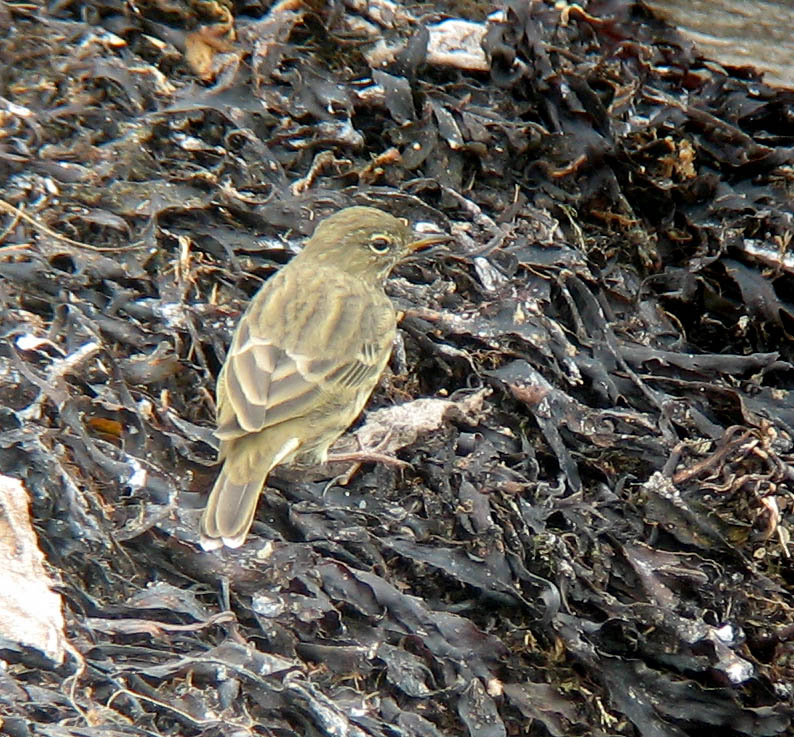- Rock Pipit
Taxobox
name = Rock Pipit
status = LC | status_system = IUCN3.1

image_width = 240px
regnum =Animal ia
phylum = Chordata
classis = Aves
ordo =Passeriformes
familia =Motacillidae
genus = "Anthus "
species = "A. petrosus"
binomial = "Anthus petrosus"
binomial_authority = (Montagu, 1798)The Rock Pipit, "Anthus petrosus", is a small
passerine bird which breeds on rocky coasts of westernEurope northwards fromBrittany . It is mainly resident inIreland ,Great Britain andFrance , in the west of its range, but theScandinavia n andRussia n populations migrate south in winter.Like most other
pipit s, this is undistinguished looking species on the ground, mainly dark brown above and heavily streaked buff below. It has dark legs, pale grey outer tail feathers and a longish dark bill. Its dark plumage is an adaptation to the rocky coasts on which it breeds and winters.West European birds (race "petrosus") remain dark grey-buff all year. Scandinavian and Baltic Sea birds (race "littoralis") may show pinkish underparts and a pale supercilium in summer, thus resembling the closely related
Water Pipit , with which Rock Pipit was previously considered conspecific (Sangster "et al.", 2002); they are usually indistinguishable from "petrosus" in winter.Judging from external (Alström & Mild, 1987) and molecular (Voelker, 1999) characteristics, this species and the Water Pipit are very closely related. They can be told apart by their song (Leonovich "et al", 1997), and while they may be found in the same general area occasionally, they do not utilize the same habitat (Bijlsma, 1977). Rock Pipits tend to be found along rocky coasts whereas
Water Pipit s favour damp grassland. The Rock Pipit is a much tamer bird than the Water Pipit; if startled, it flies a fairly short distance, close to the ground, before it lands again.This species is insectivorous. Its call is an explosive "fit". The song, as in many pipits, is a series of "blocks" of repeated more or less shrill cheeping single or double notes; it ends on a trill and has usually fewer, but longer-lasting "blocks" (a dozen repetitions or more) than in the Water Pipit.
References
* Alström, Per & Mild, Krister (1987): Some notes on the taxonomy of the Water Pipit complex. "Proceedings of the 4th International Identification Meeting" (Eilat): 47–48. Eilat: International Birdwatching Center.
* Alström, Per & Mild, Krister (1996): The identification of Rock, Water and Buff-bellied Pipits. "Alula" 2(4): 161–175.
* Bijlsma, R. (1977) Voorkomen en oecologie van "Anthus spinoletta" en "A. s. littoralis" in de uiterwaarden van de Rijn bij Wageningen. "Limosa" 50: 127–136. [Article in Dutch]
* Database entry includes justification for why this species is of least concern
* Leonovich, V. V.; Deminia, G. V. & Veprintseva, O. D. (1997): [On the taxonomy and phylogeny of pipits (Genus "Anthus", Motacillidae, Aves) in Eurasia] . "Biulleten Moskovskogo obshchestva ispytatelei prirody. Otdel biologicheskii". 102(2): 14–22. [Article in Russian]
* Voelker, G. (1999): Molecular evolutionary relationships in the avian genus "Anthus" (Pipits: Motacillidae). Molecular Phylogenetics and Evolution 11(1): 84–94. DOI|10.1006/mpev.1998.0555 (HTML abstract)
Wikimedia Foundation. 2010.
